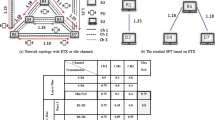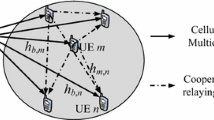Abstract
Data transmission over wireless networks become increasing the energy levels which has the attention of both the routing data and the better communication in network. Due to lacking of improper network signals and the effluence it causes to the energy consumption in wireless network. With the progressive advancement in CDMA based radio communication channels are used to make better communication. This allow the multicasting techniques covers through transmitters to send he data in a single communication channel. To propose a Multi linear adaptive sequence transmission (MAST-CDMA) used to sense the channels for sequence linearity to transfer the data to make decisions without traffic constraints on periodic times. The routing impacts of packets over the network transmitters are based on the Multicast neighbor data communication (MNDC).The adaptive technique reduce the energy consumption over delay occurred on bandwidth consideration through transmitter in single channel communication. The newly communication intent are neighbor routing which is examined by traffic flow analyze the transmission consumption to improve the energy level constraints to produce improved network efficiency.






Similar content being viewed by others
Change history
06 June 2022
This article has been retracted. Please see the Retraction Notice for more detail: https://doi.org/10.1007/s12652-022-04074-7
References
Bettstetter C (2002) On the minimum node degree and connectivity of a wireless multihop network. In Proc. Lausanne, Switzerland, June, ACM MobiHoc, pp 80–91
Datta U, Kundu S (2012) Packet size optimization for multi hop CDMA wireless sensor networks with nearest neighbors based routing. In: 2012 third international conference on emerging applications of information technology
De S, Qiao C, Pados DA, Chatterjee M, Philip SJ (2004a) An integrated cross-layer study of wireless CDMA sensor networks. IEEE J Sel Areas Commun 22(7):1271–1285
De S, Qiao C, Pados DA, Chatterjee M, Philip SJ (2004b) An Integrated Cross-layer Study of Wireless CDMA Sensor Networks. IEEE J Select Areas Commun 22(7):1271–1285
Foukas X, Patounas G, Elmokashfi A, Marina MK (2017) Network slicing in 5g: survey and challenges. IEEE Commun Mag 55(5):94–100
Kamal Jain, Jitendra P, Venkata N, Lili Qiu, "Impact Of Interference On Multi-hop Wireless Network Performance", MobiCom '03 Proceedings of the 9th annual international conference on Mobile computing and networking, pp. 66–80, September 2014 .
Kang H, Hong H, Sung S, Kim K (2008) Interference and sink capacity of wireless CDMA sensor networks with layered architecture. ETRI J 30(1):1
Karrenbauer M, Weinand A, Lianghai J, Schotten HD (2018) Network slicing in local non-cellular wireless networks: a MC-CDMA-based approach. 2018 15th International Symposium on Wireless Communication Systems (ISWCS)
Kim Y, Lee H, Ahn J, Chung J (2019) Selection of CDMA and OFDM using DNN in underwater acoustic channels. In: 2019 eleventh international conference on ubiquitous and future networks (ICUFN)
Kirankumar Y, Jayashree D (2015) Node placement in wireless sensor network: an energy approach. In: National conference on recent advances in electronics and computer engineering (RAECE), pp 40–45
Kirousis LM, Kranakis E, Krizanc D, Pelc A (2000) Power consumption in packet radio networks. Theor Comput Sci 243:289–305
Kleinschmidt JH, Borelli WC, Pellenz ME (2007) An analytical model for energy efficiency of error control schemes in sensor networks. In: IEEE Communications Society, ICC 2007 proceedings, pp 3895–3900
Kumar N, Dash D (2020) Flow based efficient data gathering in wireless sensor network using path-constrained mobile sink. J Ambient Intell Human Comput 11:1163–1175. https://doi.org/10.1007/s12652-019-01245-x
Kurniawan DWH, Kurniawan A, Arifianto MS (2017) An analysis of optimal capacity in cluster of CDMA Wireless Sensor Network. In: 2017 international conference on applied computer and communication technologies (ComCom)
Liu BH, Chou CT, Lipman J, Jha S. Using frequency division to reduce MAI in DS-CDMA wireless sensor 2000 networks.
Mohamad Reaz S, Mostafa R, Gelareh V (2015) Sensor clustering and base station mobilizing in Wireless Sensor Networks using genetic algorithms. International Congress on Technology, Communication and Knowledge (ICTCK), pp 542–546
Mukherjee S, Singh JP (2009) Reducing MAI in cluster based sensor network using FDMA-CDMA technique. In: 2009 IEEE international advance computing conference
Muqattash A, Krunz M (2003) CDMA-based MAC protocol for wireless ad hoc networks. MobiHoc
Panichpapiboon S, Ferrari G, Tonguz OK (2006) Optimal transmit power in wireless sensor network. IEEE Trans Mobile Comput 5(10):1432–1447
Petrosky EE, Michaels AJ, Ridge DB (2018) Network scalability comparison of IEEE 802.15.4 and receiver-assigned CDMA. IEEE Internet Things J 1–1
Ramnathan R, Rosales-Hain R (2000) Topology control of multihop wireless networks using transmit power adjustment. In: Proc. Tel-Aviv, Israel, Mar, IEEE INFOCOM, pp 404–413
Author information
Authors and Affiliations
Corresponding author
Additional information
Publisher's Note
Springer Nature remains neutral with regard to jurisdictional claims in published maps and institutional affiliations.
This article has been retracted. Please see the retraction notice for more detail: https://doi.org/10.1007/s12652-022-04074-7
About this article
Cite this article
Mohan, N. RETRACTED ARTICLE: Multi linear adaptive sequence transmission based code division multiple access using multicast neighbor data communication in wireless network. J Ambient Intell Human Comput 12, 6307–6316 (2021). https://doi.org/10.1007/s12652-020-02207-4
Received:
Accepted:
Published:
Issue Date:
DOI: https://doi.org/10.1007/s12652-020-02207-4




